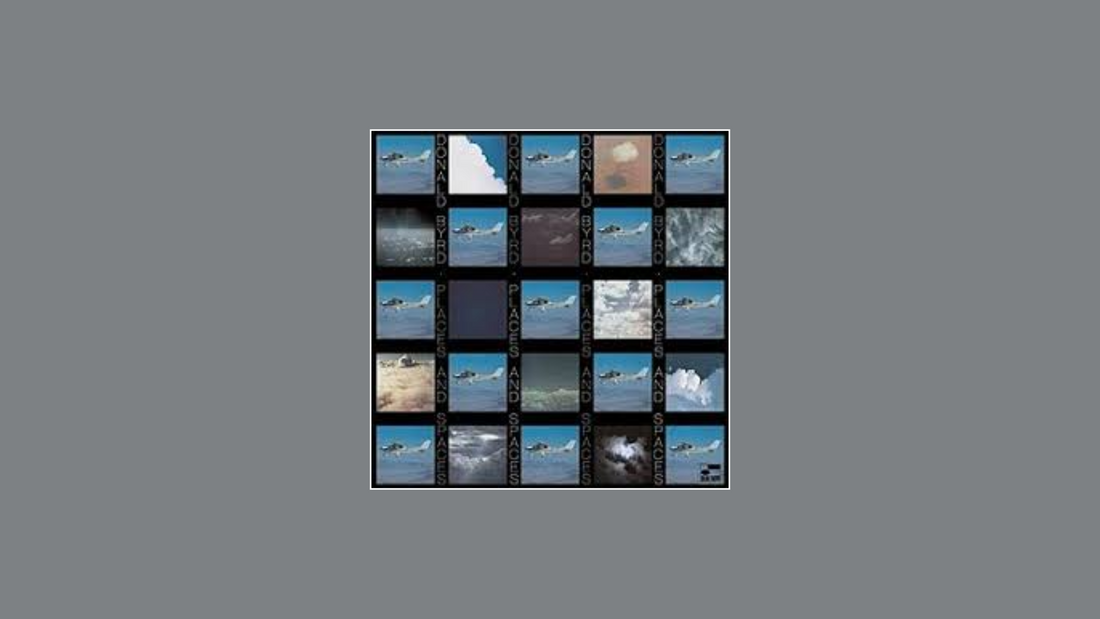
Donald Byrd – Places and Spaces (1975)
By Rafi Mercer
Some records feel like doorways. Put them on and you step into a different light, a different air, a different city at night. Donald Byrd’s Places and Spaces, released in 1975 on Blue Note, is one of those records. It does not simply play; it arranges the room. A jazz trumpeter steeped in bebop traditions, Byrd could have stayed in the familiar lanes of hard bop. But with this album, produced by Larry and Fonce Mizell, he stepped boldly into something else: a fusion of jazz, funk, and soul so polished, so aerodynamic, that it became a touchstone for a generation of musicians, DJs, and producers. It is a record that moves — not just rhythmically, but culturally, across borders and through time.
Drop the needle on side one and “Change (Makes You Want to Hustle)” glides out with strings, groove, and voice all woven into a shimmering fabric. This is not jazz as head-solo-head structure. It is groove music, a continuous current designed for both radio and dancefloor, yet complex enough to keep the most discerning ears engaged. Byrd’s trumpet cuts through with lyrical brightness, while the Mizell Brothers’ production ensures that every detail — from the hi-hat shimmer to the bass throb — carries weight. Played through a serious sound system, the track has the clarity of glass and the warmth of sunlit wood.
By the mid-70s, Blue Note had entered its fusion era, and Byrd was at the centre of it. He had already released Black Byrd (1973), which became the label’s best-selling album, but Places and Spaces refines that formula into something sleeker. The Mizell Brothers bring their signature touch: lush arrangements, layered vocals, an openness to funk and R&B that was both commercially savvy and musically adventurous. The result is an album that feels like movement itself — urban, nocturnal, expansive. It is as if Byrd had built a bridge between smoky clubs and neon-lit boulevards.
The highlight for many is “Dominoes,” a track that floats with almost weightless rhythm. The horns punch in unison, the groove is unshakeable, and Byrd’s trumpet soars with an ease that belies its precision. The vocals — lightly applied, never overbearing — give the track a human centre, a reminder that this is music meant to connect. Heard in a listening bar, “Dominoes” has the power to shift the evening up a gear, to bring the room into focus. It is danceable without being demanding, stylish without being slick.
“Wind Parade” is perhaps the most enduring cut, a track that has been sampled and reinterpreted countless times in hip-hop and electronic music. Its melody is both simple and unforgettable, a horn line that feels inevitable once you’ve heard it. The groove is supple, the arrangement expansive without excess. There is a sophistication here that makes it timeless. On vinyl, the track breathes differently — the strings swell with more air, the bassline has more grain, the horns shimmer with tactile presence. It is no accident that crate diggers and DJs have returned to this cut for decades. It has that rare combination of accessibility and depth.
What sets Places and Spaces apart is not just the grooves but the atmosphere. This is not music locked in its time; it still feels contemporary. The Mizell production style — strings used as texture rather than ornament, rhythm guitars as propulsion rather than decoration, horns as architecture rather than flourish — set a template that can be heard in everything from acid jazz to neo-soul. When Brand New Heavies, Jamiroquai, or even contemporary producers like Kaytranada construct their layered, groove-driven worlds, you can hear the echo of Byrd and the Mizells.
For deep listening, the album is a study in balance. Each instrument occupies its space with clarity. The rhythm section never crowds, the strings never swamp, the vocals never overstate. Byrd’s trumpet, though often sparing, is placed with intent. He does not need to dominate; his presence is enough. Listening through high-end speakers, one hears not just the notes but the placement, the decision-making, the craft. It is a record that rewards attention but does not demand it — you can lean in or let it carry you, and it works either way.
One of the pleasures of Places and Spaces is how it reclaims the idea of sophistication. In lesser hands, the fusion of jazz and funk could tip into kitsch or easy listening. But here, the polish is purposeful. The grooves are meticulous, the arrangements tight, the production pristine. It is not background music; it is foreground atmosphere, designed to elevate the environment it inhabits. Play it in a bar and the lights seem warmer, the crowd seems sharper, the air feels charged.
There is also something to be said for Byrd’s willingness to evolve. Many jazz musicians of his generation resisted fusion, seeing it as a dilution of the art form. Byrd embraced it, not as compromise but as exploration. He saw that jazz could speak through groove, that improvisation could coexist with production, that sophistication could include funk. This openness is why the record endures, why it feels less like a relic and more like a living text.
Consider the title itself: Places and Spaces. It suggests geography, architecture, expansiveness. The music matches the title, creating environments rather than mere songs. Each track feels like a different district of the same city — some bustling, some tranquil, all connected. To listen to the album is to take a journey, to walk through a soundscape designed with both elegance and vitality.
In the Tracks & Tales context, this is a record that belongs both in bars and at home. In bars, it is the sound of early evening energy, the point where anticipation begins to rise and the night starts to lean forward. At home, it is the soundtrack to windows open, city lights outside, a drink in hand. It is urbane, stylish, but never cold. It has the rare quality of making space feel more alive.
Why does it belong in the canon of deep listening? Because it proves that groove can be as profound as harmony, that atmosphere can be as powerful as virtuosity, and that production itself can be an instrument of expression. It is music that teaches you how to listen to space as much as to notes.
Donald Byrd would go on to explore many directions, but Places and Spaces remains his most perfect alignment of vision and execution. It is a record that captures not only the sound of a time but the sound of a future that was still unfolding. Nearly fifty years on, it has lost none of its lustre.
Drop the stylus, let the strings swell, let the trumpet guide. The night has begun, and this is the doorway.
Rafi Mercer writes about the spaces where music matters. For more stories from Tracks & Tales, subscribe, or click here to read more.







